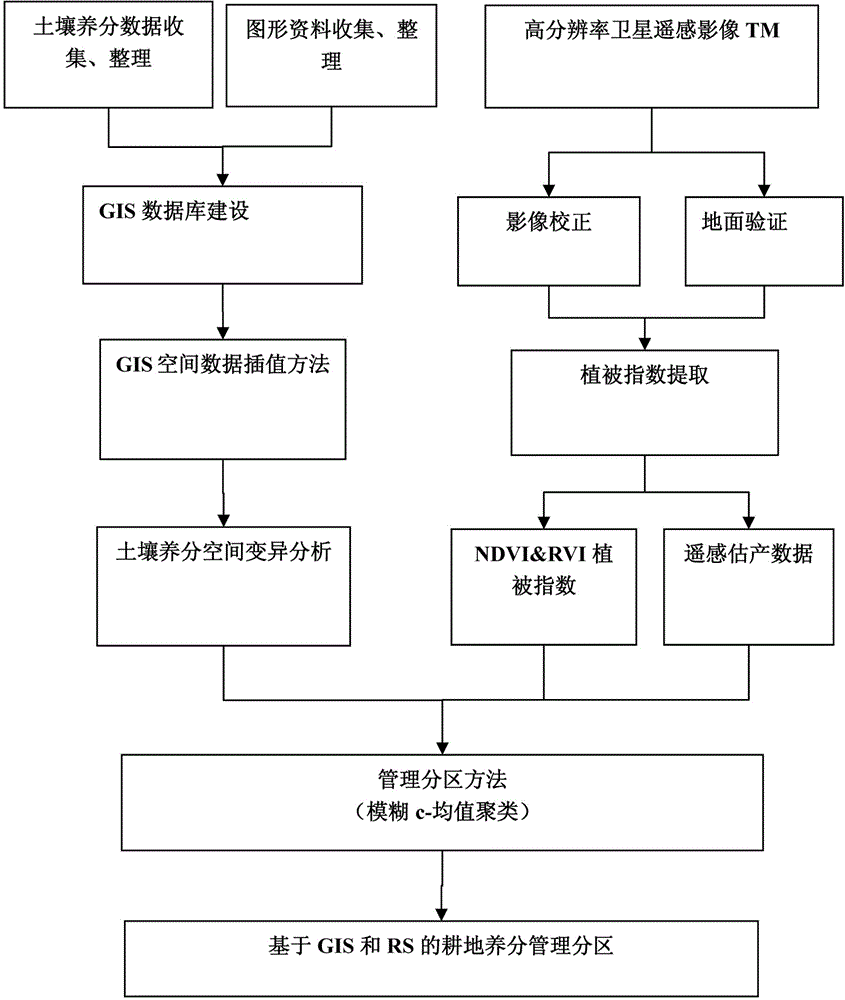Farmland nutrient management partitioning method based on GIS and RS
A technology for managing zoning and nutrients, applied in the fields of precision agriculture and agricultural informatization, can solve problems such as poor practicability, inability to truly meet the requirements of precision, and large errors, so as to reduce unreasonable fertilizer input, reduce soil nutrient imbalance, and reduce agricultural The effect of production costs
- Summary
- Abstract
- Description
- Claims
- Application Information
AI Technical Summary
Problems solved by technology
Method used
Image
Examples
Embodiment 1
[0033] Such as figure 1 As shown, a GIS and RS-based zoning method for cultivated land nutrient management, specifically includes the following steps:
[0034] A method for zoning nutrient management of cultivated land based on GIS and RS, comprising the following steps:
[0035] Step 1: Determine the best time period for crop remote sensing yield estimation, obtain appropriate remote sensing image data, and use crop phenology calendar to select appropriate remote sensing image data according to the different growth rhythms of different crops;
[0036] Step 2: Use remote sensing image processing technology to obtain a suitable vegetation index: extract the remote sensing image data of different vegetation obtained in step 1 to obtain the vegetation index according to the image processing technology, and select the vegetation index related to the yield data;
[0037] Step 3: Obtain the GPS location information and soil nutrient data of the sample soil;
[0038] Step 4: Conver...
Embodiment 2
[0048] Step 1: According to the cotton growth phenology in the study area, the Landsat-5 TM image of the study area was used, the date of reception was September 13, 2011, a total of half views, the spatial resolution was 30m*30m, the track number was 146 / 29, including 7 band, the vegetation information is displayed better.
[0049] Step 2: Select a vegetation index that can reflect better crop growth: normalized difference vegetation NDVI and ratio vegetation index RVI, NDVI=TM4-TM3 / TM4-TM3, RVI=TM4 / TM3. This study completed the verification of ground yield measurement in the study area during 7 days from September 13 to 19, 2011. After statistical analysis, the geographical coordinates and cotton yield measurement data of 64 strip fields in the study area were obtained. A regression model was established between 44 yield data and vegetation index, and the remaining 22 yield data were used for model testing. Yield estimation data is mainly used for correlation analysis with so...
PUM
 Login to View More
Login to View More Abstract
Description
Claims
Application Information
 Login to View More
Login to View More - R&D
- Intellectual Property
- Life Sciences
- Materials
- Tech Scout
- Unparalleled Data Quality
- Higher Quality Content
- 60% Fewer Hallucinations
Browse by: Latest US Patents, China's latest patents, Technical Efficacy Thesaurus, Application Domain, Technology Topic, Popular Technical Reports.
© 2025 PatSnap. All rights reserved.Legal|Privacy policy|Modern Slavery Act Transparency Statement|Sitemap|About US| Contact US: help@patsnap.com



